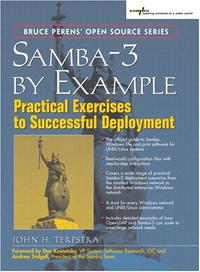Preface Network administrators live busy lives. We face distractions and pressures that drive us to seek proven, working case scenarios that can be easily implemented. Often this approach lands us in trouble. There is a saying that, geometrically speaking, the shortest distance between two points is a straight line, but practically we find that the quickest route to a stable network solution is the long way around. This book is your means to the straight path. It provides step-by-step, proven, working examples of Samba deployments. If you want to deploy Samba-3 with the least effort, or if you want to become an expert at deploying Samba-3 without having to search through lots of documentation, this book is the ticket to your destination. Samba is software that can be run on a platform other than Microsoft Windows, for example, UNIX, Linux, IBM System 390, OpenVMS, and other operating systems. Samba uses the TCP/IP protocol that is installed on the host server. When correctly configured, it allows that host to interact with a Microsoft Windows client or server as if it is a Windows file and print server. This book will help you to implement Windows-compatible file and print services. The examples presented in this book are typical of various businesses and re ect the problems and challenges they face. Care has been taken to preserve attitudes, perceptions, practices, and demands from real network case studies. The maximum benefit may be obtained from this book by working carefully through each exercise. You may be in a hurry to satisfy a specific need, so feel free to locate the example that most closely matches your need, copy it, and innovate as much as you like. Above all, enjoy the process of learning the secrets of MS Windows networking that is truly liberated by Samba. The focus of attention in this book is Samba-3. Specific notes are made in respect of how Samba may be made secure. This book does not attempt to provide detailed information regarding secure operation and configuration of peripheral services and applications such as OpenLDAP, DNS and DHCP, the need for which can be met from other resources that are dedicated to the subject. Why Is This Book Necessary? This book is the result of observations and feedback. The feedback from the Samba-HOWTO-Collection has been positive and complimentary. There have been requests for far more worked examples, a "Samba Cookbook," and for training materials to help kick-start the process of mastering Samba. The Samba mailing list"s users have asked for sample configuration files that work. It is natural to question one"s own ability to correctly configure a complex tool such as Samba until a minimum necessary knowledge level has been attained. The Samba-HOWTO-Collection, as do The Official Samba-3 HOWTO and Reference Guide, document Samba features and functionality in a topical context. This book takes a completely different approach. It walks through Samba network configurations that are working within particular environmental contexts, providing documented step-by-step implementations. All example case configuration files, scripts, and other tools are provided on the CD-ROM. This book is descriptive, provides detailed diagrams, and makes deployment of Samba-3 a breeze. Prerequisites This book is not a tutorial on UNIX or Linux administration. UNIX and Linux training is best obtained from books dedicated to the subject. This book assumes that you have at least the basic skill necessary to use these operating systems, and that you can use a basic system editor to edit and configure files. It has been written with the assumption that you have experience with Samba, have read The Official Samba-3 HOWTO and Reference Guide and the Samba-HOWTO-Collection, or that you have familiarity with Microsoft Windows. If you do not have this experience, you can follow the examples in this book but may find yourself at times intimidated by assumptions made. In this situation, you may need to refer to administrative guides or manuals for your operating system platform to find what is the best method to achieve what the text of this book describes. Approach The first chapter deals with some rather thorny network analysis issues. Do not be put off by this. The information you glean, even without a detailed understanding of network protocol analysis, can help you understand how Windows networking functions. Each following chapter of this book opens with the description of a networking solution sought by a hypothetical site. Bob Jordan is a hypothetical decision maker for an imaginary company, Abmas Biz NL. We will use the non-existent domain name abmas.biz. All facts presented regarding this company are fictitious and have been drawn from a variety of real business scenarios over many years. Not one of these reveal the identify of the real-world company from which the scenario originated. In any case, Mr. Jordan likes t Это и многое другое вы найдете в книге Samba-3 by Example: Practical Exercises to Successful Deployment (Bruce Perens Open Source) (John H. Terpstra)
Samba-3 by Example: Practical Exercises to Successful Deployment (Bruce Perens Open Source) John H. Terpstra
Подробная информация о книге «Samba-3 by Example: Practical Exercises to Successful Deployment (Bruce Perens Open Source) John H. Terpstra». Сайт не предоставляет возможности читать онлайн или скачать бесплатно книгу «Samba-3 by Example: Practical Exercises to Successful Deployment (Bruce Perens Open Source) John H. Terpstra»
